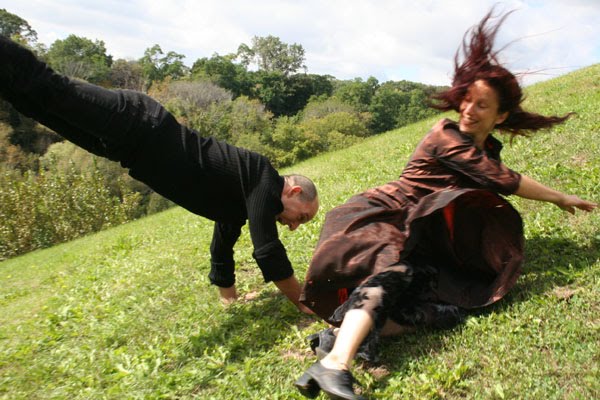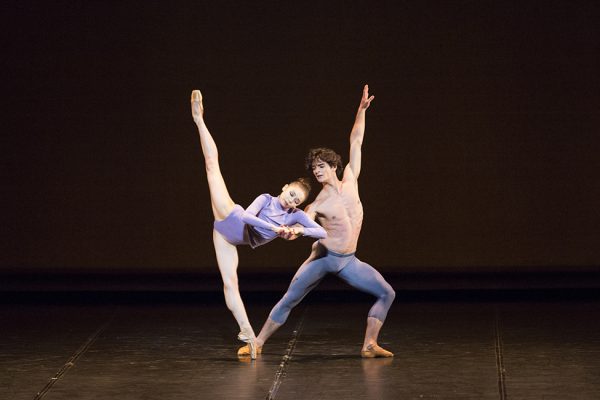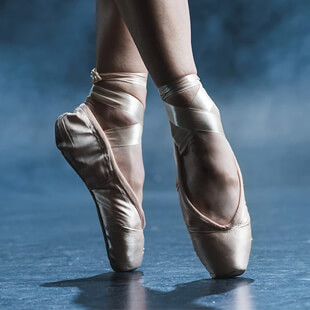For fifteen years, the fringe Festival of Independent Dance Artists (fFIDA) has presented a mixed bag of dance over an extended period in August. Chosen by lottery and stacked into mixed programs and large-scale spectaculars, the dance viewing experience has also been a crapshoot. Some years it was mostly dross with a few buried treasures; in others, the riches made you feel hopeful for the future of dance in Canada.
In 2006, fFIDA was re-invented as the Toronto International Dance Festival (TIDF), a fully curated two-week festival based in Toronto’s Distillery Historic District, and more specifically, the new Young Centre for the Arts. The programming, by Festival Artistic Director Michael Menegon, featured a number of deserving remounts, a smattering of world premieres and liberal doses of open stage and site-specific works.
Mixed Program 1
August 12, 2006
Each of three Mixed Programs at TIDF adhered to the gem/dross trope of former fFIDA’s. These shared programs opened with a different emerging artist — Barbara Lankamp at the show I attended. It’s an interesting idea that could be honed further in years to come. Lankamp’s solo “Mosaic”, performed to music by Alight and Sigur Ros, didn’t really generate the kind of excitement that would get audience members rubbing their palms together in anticipation of the rest of the program ahead. This was too bad, because at least two of the three remaining works definitely contained elements to get excited about.
Toronto-based DA Hoskins’ “Everything Ecstatic” was originally made for students at the Ryerson Theatre School Dance Program. And the work truly embodies the beauty and physical exuberance of youth in full bloom. From the opening moments when a crash of sound delivers a buff and near-naked Brendan Wyatt into a circle of light where he summarily hurls his body around in the way of the young, through various solos and duets from a great cast (including Lacey Smith and Matthew Waldie from TDT) of swimsuit-clad stunners, “Everything Ecstatic” leaves you just that. Sensuous, charged and technically furious, this choreography ain’t subtle. But it gets you worked up in a way that’s all too rare with dance.
Ghislaine Doté Danse from Montréal also pulled out the stops with her group work “L’Amentation”. The work begins in silence with a duet of aggressive connection between Jenny Brizard and Aboubakar Mane in which the performers impose themselves on each other through lifts, slaps and hugs. As the dance unfolds, what impresses is the beautiful, organic and inventive work on the floor, a combination of modern and African-based movement. I will always remember the long final tableau in which the performers (there are six, all of them accomplished) use their bodies and the floor to create a sustained percussive score disguised as dance. It was an embarrassment of riches though, and some of the impact is diminished by a tendency to be overly generous with this gorgeous material — “L’Amentation” needs an editor.
I won’t dwell on “Acquiesce”, by San Diego’s Michael Mizerany. It’s the kind of duet steeped in sexual politic that needs to be done with subtlety and compassion or not at all. In the program notes, Mizerany claims his work to be “erotic” but I found the tormented writhings of this “bitter couple” anything but.
Mixed Program 2
August 11, 2006 A highlight of TIDF for me was Montréal-based Jane Mappin’s “Pale Fire (extracts)”, part of Mixed Program 2. Here was clarity and, as the title suggests, a burning intensity. Based on the Nabokov novel of the same name, “Pale Fire” features video images by photographer Michael Slobodian and magnificent performances by Mappin and Susan Gaudreau. I would have been completely content if the piece had ended with Gaudreau’s opening solo of simple sculptural shapes under bright white light. But the work continued with Mappin bringing her own less spectacular yet equally strong performing gifts to the stage for a series of duets. Triumphant arms and expressive fingers punctuate Mappin’s choreography. I’d be most curious to see how the imagery and movement work together in a much longer piece. Hopefully, there were some local presenters in the house.
If there were, they probably wouldn’t have been too impressed with Sarah Swenson and Vox Dance Theatre from Los Angeles (there were a suspiciously large number of mediocre choreographies and uninspired performances from American dance companies at TIDF, it seems to me). Or, as my date, put it: “Please make it stop!” Short of pulling out an Uzi, there wouldn’t have been much I could do to stop “Hombres”, which used the Concierto de Aranjuez by Joaquin Rodrigo — in its entirety — as a score. The concept played on archetypal images of the male as danced by women and it was a world premiere companion piece to “Fimmine” (oh, I get it) that graced the fFIDA Open Stage 2005. And I think that’s enough said.
I’m not a fan of Motus O, up next with a selection of excerpts from their crowd-pleasing full-length show “Variations in Love”. That said, even I had to admire the stagecraft, technical assurance and accessibility of this most successful and mostly touring company. The content of “Cupid’s Lament”, “Giddy Whirl” and “Isobel” (men only want one thing and isn’t love wacky?) may have been coy and cheesy, but every once in while, even the curmudgeons in the house had to stifle a giggle at the precision comic antics of James Croker, Cynthia Croker and Jack Langenhuizen.
Mixed Program 3
August 10, 2006
Of all the mixed shows, I found this one the most consistently intriguing and satisfying. Even emerging artist Soojung Kwan and her company of killer Korean musicians, were able to come up with a sincere and spirited offering in “Opaque” — at TIDF, the work by “emerging” artists that I saw was consistently weak so this was a relief.
Menaka Thakkar has been in the business for much longer than Kwan and it showed in the exquisite pacing and stagecraft of the thirty-two-minute tour de force “Shapes and Rhythms”. With a large ensemble cast of well-trained performers, Thakkar kept the visual pleasure coming with thrilling moments of full-tilt stage crossings with stamping feet contrasted slow movement that showed off the beauty of some of the classical poses. Solid and very entertaining, in many ways, “Shapes and Rhythms” was the strongest of a strong grouping by virtue of Thakkar and company’s disciplined and well-honed chops.
Less coherent but more powerful in many ways, “In the Letters of My Name” was a collaboration between Holly Small and Sashar Zarif with dramaturge Soheil Parsa and multi-media developer Jeremy Rotstein. An intriguing narrative concerning the shape and sound of a long “A”-filled name with Arabic, Persian and Azerbaijani origins, the work is anchored by Zarif’s commanding stage presence. His theatrical expression was self-aware and physically virtuosic (at one point he spins dervish-style for a remarkable length of time then immediately begins in on another story). It’s a dazzling excess of theatrical, vocal and narrative ideas that might benefit from an editor’s hand to make it even more focussed.
The evening closed with the duet “Lingua Franca” by former Toronto Dance Theatre (TDT) member Louis Laberge-Coté and independent artist Nova Bhattacharya, who is trained in bharatanatyam. These two magnificent performers describe two solitudes, each in their separate corners, who gradually reveal a growing awareness of each other. The work culminates in a stately court dance in which the dancers perform some of the same movements but with relentless individuality. I also thoroughly enjoyed the at-times-creepy score by Philip Strong.
A Bit of Everything Else
I caught a few of the curated international companies, notably Breakbone Dance Company from Chicago and La Manga Video Dance and Company from Mexico City/New York. I did not enjoy the former’s “Logotype V2.1”. I found the combination of post-industrial imagery, aggressively forceful movement and anarchic themes terribly dated and sophomoric. Must say I enjoyed their choice of music though — the Revolting Cocks and Einsturzende Neubauten should be used more frequently in contemporary dance.
La Manga’s presentation of “The Hershey Man” in the Gibsone Jessop Gallery was a much more refined affair. A solo performance by Gabriela Medina who also choreographed the work, “The Hershey Man” is a meditation on the violence that permeates modern life. The piece utilizes video imagery (news footage mostly but some text and some brilliant use of projections, shadows and colour fields) but, because the screen is the floor on and around which the performer dances, it is both more challenging (because of the sightlines) and more meaningful (because it’s placement indicates its dual role as “set”) for the audience to access. In terms of both content and execution, “The Hershey Man” is altogether admirable: Medina is a compelling performer and she expresses the requisite urgency for an increasingly alarming state of world affairs.
The T.O. Trio mixed bill brought together three of the brightest lights of the Toronto contemporary dance scene: Claudia Moore, Marie-Josée Chartier and Peggy Baker. It’s a magnificent idea but two things could have improved it. Leaving Montréaler Dana Michel off the program would have strengthened the overall impact of the triple bill — Michael Menegon’s odd choice for emerging artist added absolutely nothing to the evening. And strong as the main presented pieces were, couldn’t Toronto’s only international dance festival have found the resources to ask these very established artists to do something other than years-old remounts? That said, the work presented was solid and worthy.
Claudia Moore presented the Lady MacBeth solo excerpt from her full-length theatrical presentation “The Castle”, in which Moore embodies the power-hungry yet guilt-wracked matriarch of Shakespeare’s tragedy. Marie-Josée Chartier performed Peter Chin’s “Mata Hari Terbenam” with exquisite clarity and an intensity that was both dignified and scary. And finally, the great Peggy Baker danced and spoke her own “Krishna’s Mouth”, the story of the baby with the entire universe between his teeth.
For me, the three artists formed a kind of treatise on the aging artist — each putting her own special spin on dancing without immortality. Moore was all grace, her busted-up body seemingly frail but her energy anything but; the younger Chartier balanced on the razor’s edge of maturity and what comes after; and Baker — subdued yet still technically awesome and emotionally as generous as ever, despite the sure knowledge of what such gifts cost. This is the kind of alchemy that a dance festival is uniquely equipped to offer. I was heartbroken to miss David Earle’s show with the Pendericki String Quartet and I understand from speaking to colleagues that it similarly offered precious artistic revelations and epiphanies.
Such epic potentials were completely squandered with the Grande Scale Event, held in the enormous Fermenting Cellar on August 17th and again on the 18th. With two exceptions (one of them less than four minutes long!), the selections for this cabaret-style program surrendered rigour to a kind of dinner theatre sensibility that I found alienating. That, and the constant rearranging of the sight lines and seating arrangements (either keep everybody moving or let them sit, please) for each “act” left me (and my companions) feeling like wallflowers at the high school prom.
The exceptions? “Ding Dang Dong”, Matjash Mrozewski’s blistering solo for Kate Franklin to a fast and furious score created by TDT dancer Valerie Calam. And Montréal choreographer Dominique Lague’s magnificent “Tome II”, a duet for Lucie Carmen Gregoire and an unidentified musician in which amplified percussion created by machine, mouth and body and inventive movement created a “he said/she said” dialectic marked by sensual humour and tremendous rigour and virtuosity.
“Plus ca change, plus c’est la meme chose” doesn’t quite sum up the new TIDF. But I found myself thinking just that far too often. In addition to some thoroughly dissatisfying programming choices, Toronto’s inaugural international dance festival was characterized by an infuriating lack of attention to front of house details — site-specific events scheduled at the same time as mainstage shows, incomplete program notes, photographers clicking away during some performances — that suggests a general lack of care. It’s less depressing to dwell on the many good things I noticed — the high quality of the dancing overall, the intermittent bursts of pure creative genius, the range of dance styles offered by the festival, the unfamiliar faces in the house (suggesting that audience members were actually there to see the dance, not because they knew someone in the cast) and, most importantly, a commitment on the part of the organizers and the dance community to a dynamic future for Toronto’s only major dance festival. It’s worth the energy and effort to get it right.
Comments:
Hi Kathleen M. Smith:
I’d like to thank you for your words about “Tome II ” in the Grande Scale Event. I’m glad you enjoyed my piece. Also, for your information, there was a mistake in the Grande Scale Event program … the choreographer-dancer is myself (Lucie Carmen Grégoire) and the vocal percussionnist, Dominique Laguë!
Thank you,
Lucie Carmen G
Tagged: Festival, Performance, Various, ON , Toronto





